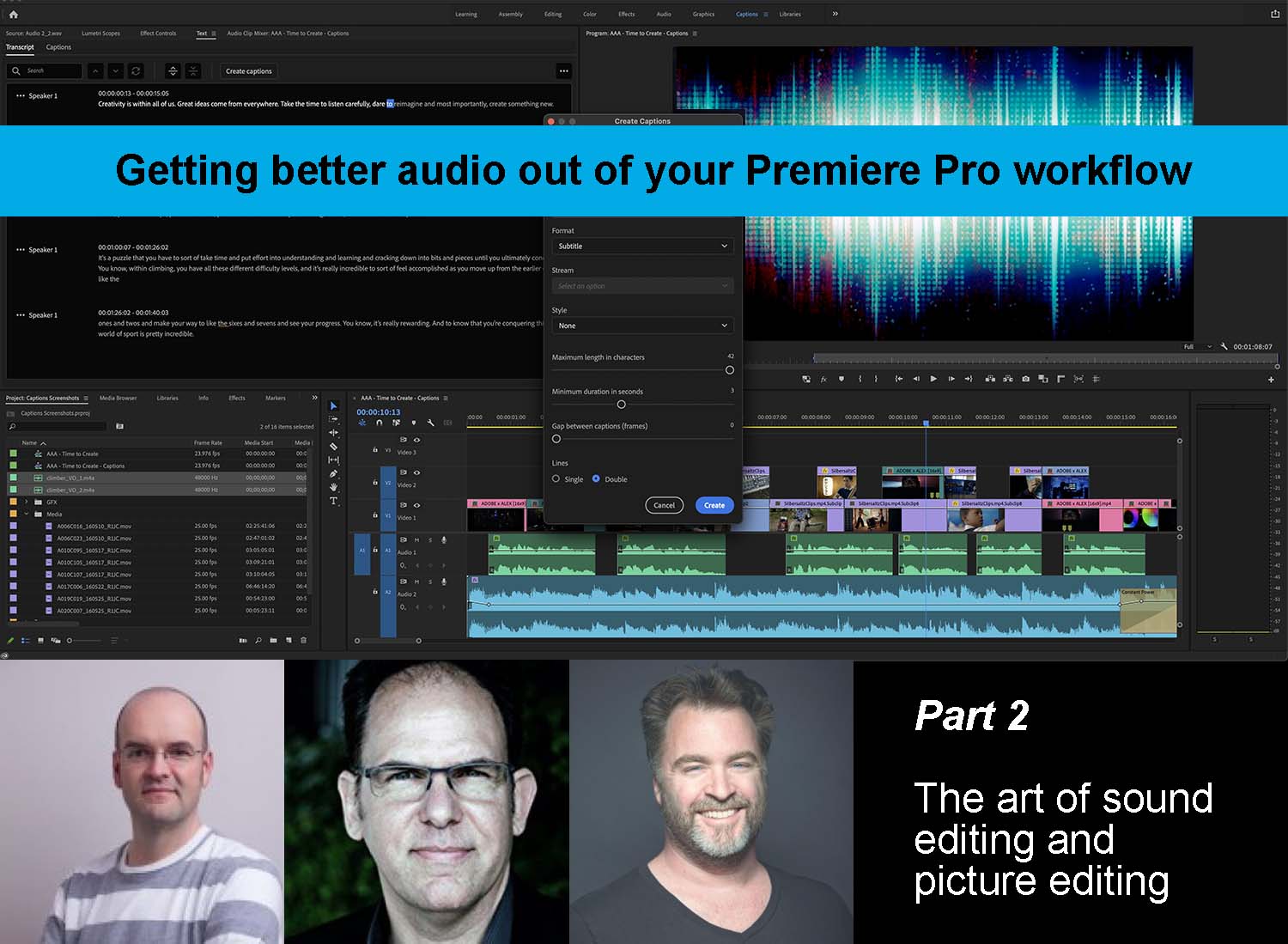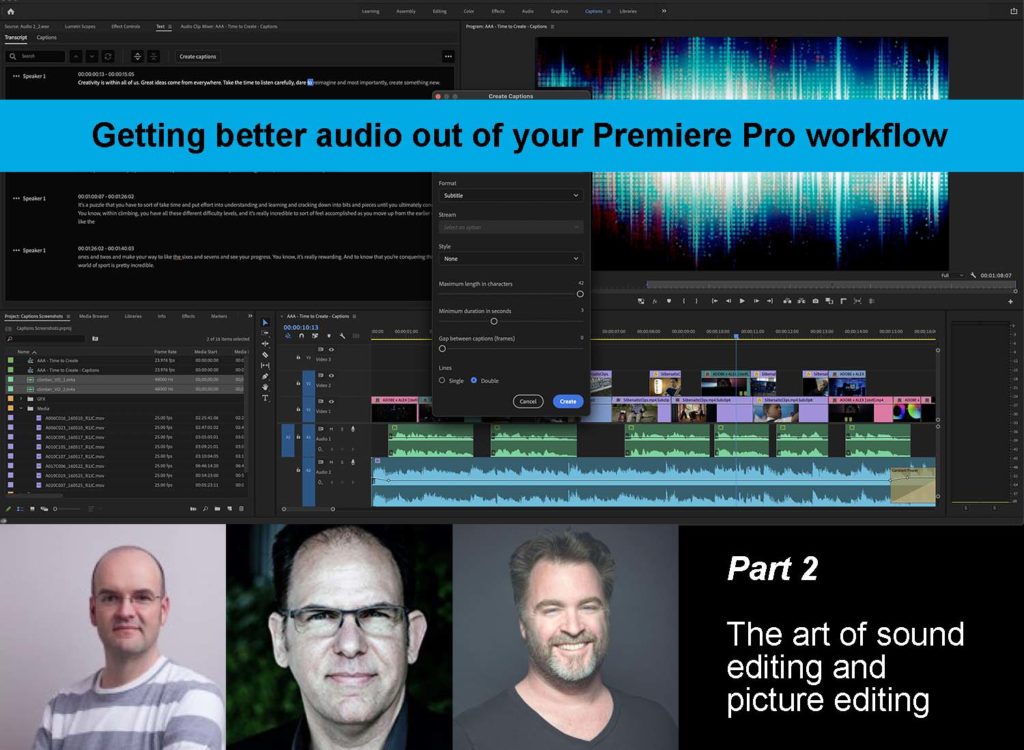
It’s always fun to talk about how new tools and innovations can create efficiencies, but many sound and picture editors don’t take advantage of the capabilities that are literally built into the solutions they use on a daily basis. A prime example of this is the audio capabilities that are built into Premiere Pro that editors either do not use or in some cases realizes are right there. What does it mean for an editor to take full advantage of the tools that they have right in front of them?
To explore what these capabilities look like and how they should both evolve and be leveraged, PVC experts Scott Simmons and Woody Woodhall connected with Durin Gleaves from Adobe. Scott in an editor in Nashville, Tennessee, which has often has him doing all the audio mixing for a given project, which isn’t ideal but is the reality of that production budget. Woody is the owner of Allied Post Audio in Santa Monica, California, where he serves as the main rerecording mixer, supervising sound editor, and sound designer. He posts feature films, feature documentaries, and a lot of television programming, and he also runs Los Angeles Post Production Group (LAPPG), which is a thriving networking community for post-production. Durin Gleaves is the Product Manager of Audio at Adobe. He arrived at the company shortly after Adobe acquired the application that became Audition, which became his main focus, but over the last few years, he’s helped define audio workflows across multiple applications in the digital video and audio segment of Adobe.
Their conversation was so big that we broke it up into three parts. They touch on everything from the logistics of working with AFF and OMF files to how Audition and Premiere work together to the potential of automated audio extraction to defining what it truly means for editors to “edit your way.”
Part 1 – Part 2 – Part 3
Woody Woodhall: I know it sounds obvious but one of the things that you guys brought up, which is key, is that the art of sound mixing and the art of picture editing are quite different skills.
Picture editors tend to look at individual clips, which makes sense. They’re putting pieces together, but sound editors are putting a million different clips together which include footsteps, door slams, gun shots, ambiances and everything else. We think of all of the various audio tracks for individual purposes in our timeline.
Whenever I’m discussing audio mixing to picture editors, what I often find is that they really don’t think or necessarily see the advantage of separate tracks for separate categories until it’s really explained to them. If you assign the first five or six tracks as dialogue tracks for instance, and then the next tracks for music, then the next tracks for sound effects, it makes the process much easier when getting to audio post. I would imagine if you are your own sound mixer as well as the picture editor it offers advantages there too. Because you’ll need to split out separate audio items when you get to delivery, so sorted tracks will when exporting only dialog for instance.
So, here’s a question for you Scott, because I’ve always wondered about this. When you say that you are responsible for the audio, sometimes all the way through, and you have a set of splits to deliver as well, is that right? You have to deliver a dialog-only track, a music-only track, an effects-only track and a narrator-track or whatever else. How do you set up your Premiere timeline? Do you use the sub mixer? Do you split out your tracks like that? How do you do it?
Scott Simmons: Yes, but it all depends on what the deliverable is.
For many picture editors doing their own mixing stuff, especially in the corporate world, you do not ever have to deliver splits. That’s something I never do, meaning that we don’t have to deliver a final piece that has the audio split into multiple different channels.
This goes back to the power of mixing in Premiere once you know it. Because there is both a track mixer and a clip mixer, you can utilize sub-mixes in the track world. So, say that I have four different people with dialog, I can create a special audio track called a sub-mix track. I can tell then tell Premiere via the track mixer, “take audio tracks one through eight and funnel those into this sub-mix track so I can apply an effect on just the sub-mix track.” It will then effect everything on those audio tracks one through eight, which in this example is all of my people that are talking. So you can really get in the weeds in a good way in how you can route the audio to do different things.
I’ll take that one step further because when you do have to deliver splits out of Premiere, it’s an incredibly difficult task of setting up the track mixture and the outputs in a way that you can get a split mix out of it. Durin, when talking about what it can mean to greatly simplify things, that’s a process in Premiere that can be greatly simplified because it’s not is not intuitive at all. That said, it’s a very specialized thing that I would probably say 90% of the mixes coming out of Premiere don’t need to deal with. So do you spend resources to make that easier?
Durin Gleaves: Ideally, I’d love to simplify that. But that gets back to what it means to be a picture editor versus a sound editor.
For picture editors, the arrangement of video elements in a timeline is hierarchical. So whatever is highest on the timeline is what’s visible on the output. So edits change perspective and focus for picture editors when they’re laying those elements out on the timeline.
On the other hand, audio is additive. It doesn’t really matter what tracks those audio clips are on. They’ll blend together and their effect is temporal. I can’t just look at the screen and hear what’s being done, but I can see what’s being done. So I think picture editors really focus on organizing the visual content in the timeline while the audio can sometimes be an afterthought.
Scott Simmons: That is generally true, and Woody has mentioned your track assignments and track names, but many people don’t name their audio channels or audio tracks in Premiere either because they don’t know they can or don’t want to bother.
That’s not the issue for me, but I don’t often name tracks in that manner because I have to move stuff around. Naming audio channel three something like “Fred’s lav,” doesn’t work because I’ll have to throw something up on there for a minute to get other things out of the way. Partly, that’s because in Pro Tools, you have this really large real estate window where you’re just looking at all audio tracks. In the video world, we’ve got all these video tracks stacked up and all these audio tracks stacked up. Additionally, we often have the source and program monitor, all on this same window so we lose the real estate that is almost a luxury when you’re working in something like Pro Tools because you don’t have so much stuff you’ve got to deal with. I think that’s why it often becomes a sloppy mess.
Now, editors should go back and clean that up before the turnover to audio and often they don’t, but that’s a whole different conversation.
Durin Gleaves: That’s a good connection to something that I’ve been thinking about for the last year, which is how can we, as Adobe, make that whole process of organization easier? I don’t know how familiar you are with Adobe Sensei, which uses AI and machine learning to make things easier. We released transcription services that are built on top of Sensei in Premiere that not only figures out what the words that were said are, but it can separate based on the speaker. So it can identify different speakers and recordings.
Is there a level of intelligence where our conversation right now would allow us to import what I’m saying onto a “Durin” track and all of what Scott is saying onto a “Scott” track? And then we could potentially bring in a “Woody” track to potentially build in those sub-mix tracks. That would make it much easier for somebody to export, dialogue, music and effect tracks as separate splits.
Woody Woodhall: You mean on an automated level?
Durin Gleaves: That’s what I envision and while I can’t go on the record in saying something we’re doing right now, that’s where I’d like us to go. Even if it’s not something that’s initially exposed, it can be unveiled when it needs to be unveiled.
Nobody likes to organize. Organizing isn’t creative and people are in this business because they like to be creative. If you’re spending all your time just doing that sort of busy work, then it’s not as an enjoyable experience. So my vision is that we can make that part of it less of a burden by bringing everybody most of the way there, making the whole process simpler.
Scott Simmons: I think that’s a perfect example of where AI can come into this world that we live in and do good things. It’s doing things that help you with the busy work and helps you with the organization so that you don’t have to individually label things one at a time. But what do you think, Woody? Does the thought of AI coming in and helping in that way scare you or make you excited?
Woody Woodhall: I think it’s fascinating. I think it’s a great idea and I hope that you guys can figure out a way to do that, I think it would help.
I can tell you that after working here in Hollywood for the last 25 years, within the last, say, five to seven years, I’m getting a lot more projects that are created in Premiere Pro. It used to be 95% Avid, but now I’m seeing a lot more Premiere Pro exports, so anything you can do on the backend to help these picture editors sort their audio would be huge.
It’s interesting because I never thought about the notion that a picture editor not only thinks about things at a clip level base but they also think in a hierarchical base, in terms of what the top track is that plays. I hadn’t really thought about that, which might be one of the reasons that sorting the audio into separate tracks is not a huge priority for most picture editors. So anything to help them on that level with identifying voices and automatically assigning voices to tracks would be most useful.
Scott Simmons: Yes, that sort of thing really would be phenomenal. And you mentioned Sensai, which is a good example of how these tools continue to change and evolve. One thing I’ve always heard from Adobe is that Premiere lets editors “edit their way.” What does that mean to you though?
Durin Gleaves: To me, it’s really about having it your way. We want to give you everything you want or that you might want but you get to choose the right method for your needs or your skill level. That said, if and when we do introduce a limitation or a change to an existing workflow, my hope is that we’ve validated it enough with users so that they understand this new way is better or faster than what they’re used to. It’s really about reducing the amount you have to think about what you’re doing to achieve what you want to get done.
Part 1 – Part 2 – Part 3

Filmtools
Filmmakers go-to destination for pre-production, production & post production equipment!
Shop Now













